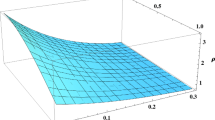Abstract
We investigate the evolution of the temperature profile of a Friedmann-like collapsing sphere undergoing dissipative gravitational collapse in the form of a radial heat flux. We further consider the behavior of the star close to quasi-static equilibrium (weak heat flux approximation) and show that relaxational effects cannot be ignored. It is explicitly shown that extended irreversible thermodynamics predict a higher temperature at all interior points of the stellar configuration compared to the Eckart theory. These results carry over to the weak heat flux approximation with the magnitude of the temperature being lower than the full radiating model. The stability of the model after its departure from equilibrium is studied by considering the behavior of the “control parameter” throughout the stellar interior.
Similar content being viewed by others
REFERENCES
Anile, A. M., Pavon, D., and Romano, V. (1998).Preprint: gr-qc/9810014.
Bonnor, W. B., de Oliveira, A. K. G.,and Santos, N. O. (1989). Radiating spherical collapse Physics Reports 181, 269.
Chan, R., Lemos, J. P. S., and Santos, N. O.(1989). Friedmann-like collapsing radiating sphere. Astrophysical Journal 342, 976.
Di Prisco, A., Herrera, L., and Esculpi, M. (1996). Radiating gravitational collapse before relaxation. Classical and Quantum Gravity 13, 1053.
Govender, M., Maartens, R., and Maharaj, S. D. (1999).Relaxational effects in radiating stellar collapse. Monthly Notices of the Royal Astronomical Society 310, 557.
Govender, M., Maharaj, S. D., and Maartens, R. (1998). A causalmodel of radiating gravitational collapse, Classical and Quantum Gravity 15, 323.
Govinder, K. S. and Govender, M. (2001). Causal solutions forradiating stellar collapse. Phyics Letters A 283, 71.
Grammenos, T. (1994). Thermodynamics of a model of nonadiabaticspherical gravitational collapse. Applied Spectroscopy 211, 31.
Herrera, L., Di Prisco, A., Hernandez-Pastora, J., Martin, J., and Martinez, J. (1997). Thermal conduction in systems out of hydrostatic equilibrium. Classical and Quantum Gravity 14, 2239.
Herrera, L., Di Prisco, A., and Pavon, D. (2000). Measuringstrength of dissipative inflation. General Relativity and Gravitation 32, 2091.
Herrera, L. and Martinez, J. (1997). On the critical behaviour of aheat-conducting fluid out of hydrostatic equilibrium. Classical and Quantum Gravity 14, 2697.
Herrera, L. and Martinez, J. (1998). Dissipative fluids out ofhydrostatic equilibrium. Classical and Quantum Gravity 15, 407.
Israel, W. and Stewart, J. M. (1976). Thermodynamics ofnonstationary and transient effects in a relativistic gas. Physics Letters A 58, 213.
Kolassis, C. A., Santos, N. O., and Tsoubelis, D. (1988). Friedmann-like collapsing model of a radiating sphere with heat flow. Astrophysical Journal 327, 755.
Santos, N. O. (1985). Non-adiabatic radiating collapse. Monthly Notices of the Royal Astronomical Society 216, 403.
Author information
Authors and Affiliations
Corresponding author
Rights and permissions
About this article
Cite this article
Govender, M., Govinder, K.S. Temperature Evolution During Radiative Gravitational Collapse. International Journal of Theoretical Physics 41, 1979–1990 (2002). https://doi.org/10.1023/A:1021065125876
Issue Date:
DOI: https://doi.org/10.1023/A:1021065125876




